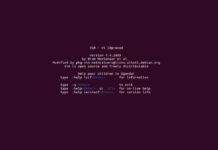 Whoever uses Linux and works with many interactive commands, possibly should have already heard about Shell Script. Shell Script is a good way to put together all the commands that we use frequently, as a sequence, in a single file.
Whoever uses Linux and works with many interactive commands, possibly should have already heard about Shell Script. Shell Script is a good way to put together all the commands that we use frequently, as a sequence, in a single file.
It can facilitate System Admin’s life, with backup routines, custom logs, disk reports, and a thousand of things.
In this article, I will show you a simple Shell Script and I will explain all the details about each line.
Things about Shell Script that we must know, before starting:
- Shell script is interpreted, so we don’t need to compile.
- We can choose a lot of command-line interpreter. i.e.: Bash (Born Again Shell), Perl, Python.
- We can run a shell script with different ways. i.e.:-
./myFirstScript.sh (dot and slash: It will run the shell script, even if It is not in the PATH sh myFirstScript.sh (It will run the shell script through sh command-line interpreter) bash myFirstScript.sh (It will run the shell script thought bash command-line interpreter)
- The file needs an execution permission.
- The file extension is not required, however sysadmins generally use “.sh” as suffix.
Let’s start…
Step 1: Create the shell script file
Choose some text editor to create your script file. It’s up to you; you can use vim or nano editor.
We will use the vim editor to create our shell script file, so enter:
vim dailyBackup.sh
Step 2: Choose a command-line interpreter:
Always, in the first line, we should choose a command-line interpreter. We chose Bash as interpreter.
The first line is the only place that # (hash/number sign) is not interpreted as a comment, so write #! and
the full name of the interpreter :
#!/bin/bash
Step 3: Add some comments to organize your script . Example:
# This script will take backups from mysql # Author Katya Longhin # Version V1.2 – 18/11/2014
Step 4: Define variables
There are different types of variables. In this case, we are defining simple variables and variables with
commands.
We are using the command date and its parameters. We can use “ to interpret a command or
$(command). So, another way to create the variable $today is: today=$(date +%Y-%m-%d):
today=`date +%Y%m%d` database=database_name user=backup_user password=your_password persist_days=7 bkp_dir=/backup dumpfile=dumpfile_$today.sql
Step 5: Create a database backup
We are displaying a message with echo command and using mysqldump to backup the database.
We are also compressing the dump file using tar command and removing from the directory, old version
of dump file.
echo "Creating database backup..." mysqldump -u$user -p$password $database > $bkp_dir/$dumpfile tar -cvzf $bkp_dir/$dumpfile.gz $bkp_dir/$dumpfile rm -rf $bkp_dir/$dumpfile
Step 6: Delete old files
We defined the variable $persist_days with a backup persistent. We will keep only backups that we
have created in the last 7 days, so we are using the find command to find all files with the suffix .sql.gz
that were created 7 days before and older.
echo "Deleting old backup files..." find $bkp_dir -mtime $persist_days -type f -name "*.sql.gz" -delete
Step 7: Send an e-mail to the administrator, if backup fails
We are creating a conditional method to send a message to the administrator.
If the file is not empty and the file exists (-s), the backup was done, else the script will send a message to
the administrator.
echo “Sending a message to the administrator, if the backup was not done” if [ -s $dumpfile ]; then echo "Backup was done..." else echo "Backup file was not created or something wrong happened \n\n Message sent by script dailyBackup.sh \n\n`date`" | mail -s "Backup error" administrator@email.com fi
The final result
#!/bin/bash # This script will take backups from mysql # Author Katya Longhin # Version V1.2 – 18/11/2014 today=`date +%Y%m%d` database=database_name user=backup_user password=your_password persist_days=7 bkp_dir=/backup dumpfile=dumpfile_$today.sql echo "Creating database backup..." mysqldump -u$user -p$password $database > $bkp_dir/$dumpfile tar -cvzf $bkp_dir/$dumpfile.gz $bkp_dir/$dumpfile rm -rf $bkp_dir/$dumpfile echo "Deleting old backup files..." find $bkp_dir -mtime $persist_days -type f -name "*.sql.gz" -delete echo “Sending a message to the administrator, if the backup was not done” if [ -s $dumpfile ]; then echo "Backup was done..." else echo "Backup file was not created or something wrong happened \n\n Message sent by script dailyBackup.sh \n\n`date`" | mail -s "Backup error" administrator@email.com fi





















































